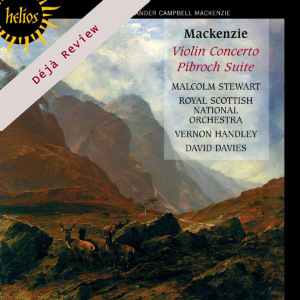
Déjà Review: this review was first published in February 2000 and the recording is still available.
Sir Alexander Mackenzie (1847-1935)
Violin Concerto
Pibroch Suite for violin and orchestra
Malcolm Stewart (violin)
Royal Scottish National Orchestra/Vernon Handley (Concerto); David Davies (Pibroch)
rec. 2009, Henry Wood Hall, Glasgow, Scotland
Originally released and reviewed as CDA66975
Hyperion Helios CDH55343 [55]
Mackenzie was born in Edinburgh in 1847. After studying at RAM and in Germany, he returned to his home city, soon coming to prominence as a violinist and conductor. He then moved to London in 1885, becoming Principal at RAM in 1888. He was an important figure in the early so-called renaissance of ‘English’ (sic) music: however, unlike, say, Parry and Stanford, with whom he is historically associated, his compositions are only rarely performed now – though again you wonder why when listening to this, the second CD devoted to Mackenzie’s music in Hyperion’s Scottish series.
The Violin Concerto was written whilst Mackenzie was living in Tuscany, and was intended for Joachim but after some prevarication he declined to play it and Sarasate premiered the work at the Birmingham Festival in 1885. It lacks any immediately memorable ‘big tunes’ that might make it an undeniably popular work, and it carries the obvious mark of both Mendelssohn and Brahms: but if it clearly reveals how much British music was at this time in the shadow of Continental, and more especially Germanic, academic strictures, it is still an easily accessible work, full of pleasing musical quality with continually attractive melodic invention.
Pibroch was written for Sarasate, and was fittingly completed whilst in Scotland, at Braemar in August, 1889: the composer called it a ‘Scottish effusion’ and the work reveals a less stifling classicism with more free-ranging musical exposition, akin to his other Scottish pieces, some of which are featured on the first Mackenzie Hyperion disc. The opening Rhapsody is a wonderfully lyrical piece, whilst the Caprice, following an introduction, comprises a sequence of nine variations on the melody of Three Guid Fellows, but with the later introduction of new material builds to an intricate coda. The theme for the Dance is derived from the 17th century melody, Leslie’s Lilt. The Scottishness of the work is more easily assimilated into classical conventions, and helps to give it that extra appeal beyond that often dry, craftsman-like academicism that marked so much of the music of the period.
Vincent Budd
Help us financially by purchasing from




















